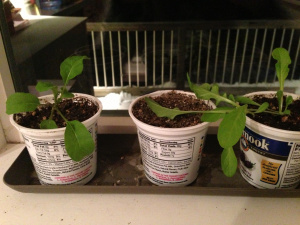Kristy Athens's Blog, page 6
February 9, 2014
New Review of Get Your Pitchfork On!
What I wouldn’t give for a warm, home-grown tomato off the vine right now! As a Northerner, it’s just not going to happen. But—that doesn’t mean I can’t have any garden at all.
As I mentioned in November of last year, I was impressed with Niki Jabbour’s The Year-Round Vegetable Gardener—as a native Midwesterner; former resident of Klickitat County, Washington; and current resident of Wallowa County, Oregon, I know how unlikely a winter garden can seem. But Niki’s from Nova Scotia, so if she can do it, I can!
The best I’ve done so far—arugula and lettuce on a windowsill …
Niki and I traded books, and her review of Get Your Pitchfork On! came out this week. I have to thank her for her complimentary and insightful review. It’s so rewarding when someone really responds to the book.
I’m super-pleased for Niki that her second book, Groundbreaking Food Gardens, will be out in March! Judging by her first one, this book will be full of helpful tips and ideas, and be organized and written well, with lots of great photographs.
Trading books is super fun—if any other writers out there are interested, please contact me.


February 2, 2014
Pupdate
Cap’n and Pendleton just passed the four-month mark, so I thought it might be time for an update. They are coming along! Pretty good with vocal commands, though they do take off at least once a day during our walks in the field, and lose their ability to hear human voices. In related news, they are also learning to walk on leash. Mike just taught them to catch a treat in the air. I am working on having one do one thing (stay) while the other does another (come), so they listen for their name and not just the command.
Pendleton has overtaken Cap’n in size—at the last veterinary visit he weighed 33 pounds to Cap’n’s 29.8. This makes sense, as 1) He is male and 2) He is taking after his golden retriever mother, while Cap’n is taking after her border collie father. Pendleton is stronger but Cap’n is faster and more coordinated.
One last hurdle to overcome, so we can socialize them, is for Cap’n to stop throwing up in the car! This makes it difficult to take them anywhere. She is definitely a lady, with a delicate constitution, easily hurt feelings, and Disney-grade eyelashes. That said, she is a lady dog, so loves digging up mouse nests and finding coyote-abandoned deer forelegs as much as her brother.
But enough description—what you really want are photos!
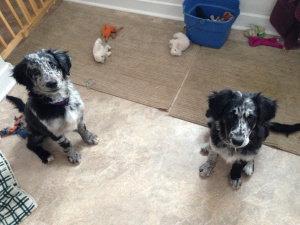
They are hard to photograph–it’s rare they are both holding still
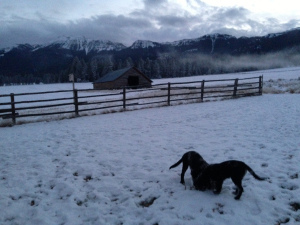
Digging up a mouse nest
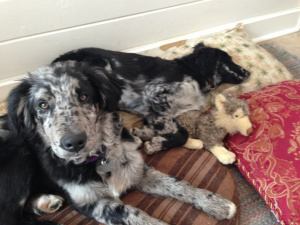
Pendleton, Cap’n, and a little friend


January 26, 2014
Pragmatism With Big Ag
Note: As a student in Marylhurst University’s Food Systems and Society master’s program, I am writing a lot. When I started the year I was a bit concerned that I wouldn’t have time to also write my weekly blog posts. That concern has born itself out—it’s been a struggle! But I recently had an epiphany: I could use some of my writing from last quarter in my blog posts. So, the following is an essay I wrote, citations and everything!
My goal in considering solutions for the food system is to challenge Big Agriculture without becoming an apologist for it. As I noted in [a previous essay], I value small-scale farms and community gardens but doubt they alone can solve the food crisis. I feel that if Big Ag can be coerced to embrace more sustainable practices, as is being attempted within energy industry policy with solar and wind power, or the automobile industry with more efficient cars, more headway will be made than by trying to replace Big Ag with something else. In this way, I consider myself a pragmatist.
As noted in Bennett et al, being a pragmatist is somewhat dicey: “When praised, the pragmatist is credited with hard-headed attention to what it takes to get things done, combined, perhaps, with a necessary indifference to abstract questions concerning the good and the true. [Author’s note: I would put ‘good’ and ‘true’ in quotation marks.] When blamed, the pragmatist is contrasted with the ‘person of principle,’ who ignores the world’s political realities and holds fast precisely to those considerations of the good and the true that must not be slighted or compromised in the interest of achieving some desired end” (2005).
There is a tradition in the United States of supporting an entity until it becomes too powerful, at which time then it becomes reviled in popular culture (though still powerful). Examples: Microsoft; Britney Spears [substitute Justin Bieber in light of recent events]; Facebook; Science; Monsanto. This is made easier by the fact that entities that become too powerful almost always abuse their power. Monsanto is an interesting case, as it’s become the scapegoat for all industrial agriculture—Archer Daniels Midland, Cargill, or ConAgra are rarely mentioned for similar pursuits. While Monsanto spent more than $8 million on the Prop. 37 campaign in California in 2012, DuPont spent $5.4 million (Voter’s Edge, 2012). But few protesters mention DuPont on their placards. Pointing this out sometimes makes me appear to be speaking up for Monsanto, when really I’m just trying to paint a more complete picture.

Source: http://www.indymedia.ie/article/103610
Along the same lines, I might appear to be defending Big Ag when I suggest that they might need to be included in, rather than routed from, a solution to our food crisis. As Holt-Giménez and Wang note, “If the history of U.S. capitalism and social change is a reliable guide, we can be assured that substantive changes to the corporate food regime will not come simply from within the regime itself, but from a combination of intense social pressure and political will” (2011). But it can happen. The successful photocopy corporation Kinko’s added Forestry Stewardship Council (FSC)-certified paper to its selection (GreenBiz.com, 2003). Nike changed its corporate policies to improve working conditions and compensation. The effect of scale when a corporation makes a change like this is much more significant than that of a bunch of smaller companies.
If Big Ag were convinced, via social pressure and/or political will, to halve its pesticide use, the result might eclipse all of the organic community gardens combined. The public never tried to eliminate Kinko’s or Nike (not to mention such effort would be futile); they simply sent a message to act like responsible global citizens. If Big Ag is approached in the same way, we might see similar results.
References:
GreenBiz.com. (2003, July 17). Kinko’s adds first FSC-certified paper. Retrieved from http://www.greenbiz.com/news/2003/07/17/kinko%E2s-adds-first-fsc-certified-paper
Holt-Giménez E. and Wang Y. (2011). Reform or Transformation? The pivotal role of food justice in the U.S. food movement. Race/Ethnicity: Multidisciplinary Global Contexts, 5(1), 83-102.
Nisen, Max. (2013, May 9). How Nike solved its sweatshop problem. Business Insider. Retrieved from http://www.businessinsider.com/how-nike-solved-its-sweatshop-problem-2013-5
Voter’s Edge. (2012, Nov. 6). Prop. 37: Genetically engineered foods. Retrieved from http://votersedge.org/california/ballot-measures/2012/november/prop-37/funding#.UpVnxo3EGuQ


January 19, 2014
2013 GYPO Blog in Review
I’ve been working on this blog for two years now! WordPress, the host of this blog, prepared a 2013 annual report. It’s pretty fancy! So, I thought I would share it. Thanks for reading the Get Your Pitchfork On blog!
Here’s an excerpt:
A New York City subway train holds 1,200 people. This blog was viewed about 6,100 times in 2013. If it were a NYC subway train, it would take about 5 trips to carry that many people.
Click here to see the complete report.


January 12, 2014
Plein Air Rising
I wrote in a 2012 GYPO blog post about participating in a special writing event in the Columbia Gorge every fall, the Plein Air Writing Exhibition. In fact, I ran the event for a couple years and launched the first online anthology in 2008. Next to the Oregon Book Awards, it was my favorite literary event of the year. I liked that it was different writing from what I was usually doing, short fiction and essays. I liked that it was an excuse to sit outside for hours at a time, simply observing things and not feeling like I ought to be cleaning out the chicken coop or mending fence.
When I was invited to serve as the Harney County Writer-in-Residence in 2010, I based my curriculum for everyone I worked with—from kindergarteners to adults—on this experience of writing en plein air. We all bundled up and went outside, ignoring the springtime chill, and observed: What do we see? What do we hear? What do we feel? The younger kids dictated their thoughts to me; the older kids and adults wrote their own pieces. These, too, were collected in an anthology.

Students in Diamond laboring over their work
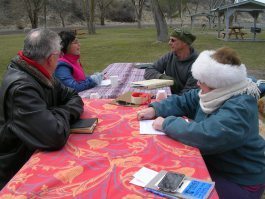
It was especially cold for this workshop in Burns!
Over the years, I have accumulated a manuscript’s worth of pieces. I’ve published a few—in the Plein Air anthologies of course, but also in High Desert Journal and Eclectic Flash, and submitted them to Literary Arts’ Oregon Literary Fellowships program. This year, they appealed to judge Amy Leach, and I was awarded a fellowship!
Many years ago (1999 – 2006) I ran this very program myself, and so it means a great deal to me to be recognized by it. I know, intimately, how much work it is for program manager Susan Denning, so I want to take the opportunity to publicly recognize her efforts to keep the OLFs running smoothly.
I also want to thank the Columbia Center for the Arts (CCA) for keeping the Plein Air Writing Exhibition going for nine years. And Pat Case, whose idea it was originally to add a writing component to the painting competition, and who invited me to participate in the first event.
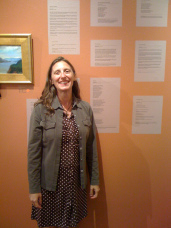
Plein Air writing on display in CCA gallery, 2010
The nonfiction judge, Amy Leach, wrote this about the manuscript:
“In each of her short and radiant portraits of the Columbia River Gorge, Kristy Athens captures a distinct moment in a distinct place. Entering imaginatively into the disparate purposes of basalt, dahlias, spent strawberries and antiquated stairways, she writes with fellow feeling and wit about a remarkable range of lives, thrilling with the quiddity of each. A prosperous pear tree throws away perfect fruit; an obsolete tractor is revived by its own exploding boiler; solitary ponderosas leave the observer ‘pondering deep-rooted complexity.’ These encounters of a sympathetic, nimble mind with a marvelous place remind us of the limitlessness of life.”
Wow! You can view some of the pieces included in this collection via my website: scroll down to the Basalt Becomes You section.


January 5, 2014
Night Sky
Any of you who saw me read from Get Your Pitchfork On at a bookstore or library may recall that I ended each presentation with the introduction to the Land Section. It’s a kind of a love-letter to the land, which is my main motivation for country living. In it, I talk about the brilliance of a full moon and the devastating beauty of a starlit, moonless night. Well, as beautiful as it was in the Gorge, in Wallowa County there is exponentially more drama.
Part of the difference is that I am forced, by way of needing to let the puppies out to pee, to be up at 4-or-so every morning. I love sleep too much to say I’m happy about this, but I will go so far as to admit that I’m grateful for the opportunity to hear Great Horned owls talking from tree to tree around our yard; see elk crunch across the area just outside the fence; hear coyotes working themselves into a shrill frenzy out past the barn.
Part of it is our remarkable location. From our house, west of and about a hundred feet higher than the towns of Enterprise and Joseph, we see pretty much the entire northern half of the Wallowa Valley, foothills trailing off behind the East Moraine of Wallowa Lake, layer after layer, with the horizon being drawn by the Seven Devils of Idaho. Idaho! Some 40 miles away. Behind us looms Ruby Peak and the rest of the Wallowa Mountains wrapping around us toward the north.
As I was writing this post, the sun dipped behind the mountains behind me. Blue shadows dropped down the slope, engulfed Enterprise and Joseph, and then the far ridge. But the Devils were still lit by the sun. In fact, they reflected the sunset, bright orange-pink—a dazzlingly bright, mountainous median surrounded by dim winterscape.
And the moon. I’ve seen some good moons in my day. But somehow the moon is more show-off-y out here. I’ve seen the Harvest and Hunter’s moons rise above the sparse lights of Enterprise like the Great Pumpkin. I even saw it set, early one morning, behind my neighbor’s house. A couple times a small, white moon has risen above the Devils while they were lit up with sunset.

Moon setting behind my neighbor’s house at 5 a.m.
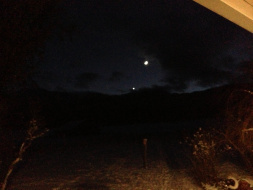
Moon and Venus above the Wallowa range
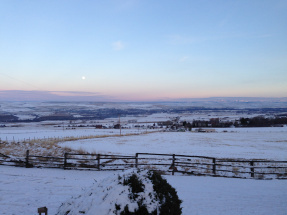
I really need to get a real camera, living up here
And, since this post is about the night sky, I haven’t even mentioned the sunrises! Lighting up the hills; calling us to the day. Last week we had freezing fog for two days, and Mike was able to watch the entire sunrise because it was obscured enough to not threaten his retinas. It was an orange orb, rising like—the moon.


December 29, 2013
The Great Escape
Living in the country means interacting with wild animals on a regular basis. We pull into our driveway at night to find it’s full of deer. Elk pass through our field to get to our neighbor’s hay bales. Quail keep trying to roost in our fantastic straw-lined dog fort. The animals usually vacate once you’ve made your presence known. Sometimes, they need your help.
Our carport is coveted by many in the valley—it’s three-sided, roomy and stable. We own ice scrapers for our windows but haven’t had to use them, and our car and truck started even when the temperature dropped below zero for days on end. The owners of this house very thoroughly covered the interior ceiling and the top third of the walls with bird netting to keep the resident starlings, mourning doves, and magpies from moving in (a flock of pigeons has taken over the nearby old barn, so their concerns are not unfounded). But like any barrier, what keeps out can also keep in.
The other day I passed through the carport to take the garbage out and heard a Steller’s jay carrying on. Such noisy birds! It took a few seconds to realize the bird was only a few feet away, in the rafters. Inside the bird netting.

Center: Little Lost Ms. Steller’s Jay
The plastic netting had been painstakingly stapled to the rafters and exposed studs at close intervals, but the bottom wasn’t closed off between the studs. This bird had landed below the netting and then, who knows why, flown straight up and then been unable to retrace her “steps” back out. Her squawks were panicked and frequent, reminding me of the time a scrub jay got into our house in White Salmon, and I had to chase him down wearing leather gloves on so I could carry him outside.
As demonstrated with our eviction of a squirrel in Portland a year ago, one must create an escape route and then usher the frantic creature toward it. Mike was still at work, so I would have to be methodical. I studied the rafters. I wanted to remove as little netting as possible to avoid having to replace it later. I noticed that there were some wasps’ combs near the entrance to the carport—perfect! I could kill two birds with one stone (so to speak; no offense, Ms. Steller’s jay). I carefully peeled back the corner, ripping the netting as little as possible.
Then I had to convince the bird to go over there. There was enough loose material to physically allow it; it was just a matter of ushering her. I had act like two people, and I had to be tall. I grabbed a broom and a stepstool and set up at the back of the carport. I whooshed the broom this way and that, trying to corral her toward the open corner. After a couple of false starts, she darted in the right direction, and was off! She lit into a nearby tree and told her story to anyone who would listen.
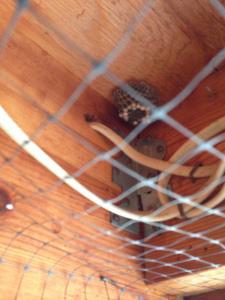
I don’t mind wasps, but not in the carport
Meanwhile, I dragged the stool over to the open corner and pulled the wasp combs out. Just another day in the country.


December 22, 2013
Heading Toward the Light
It’s Solstice. Shortest day of the year, longest night. Now, we start heading toward summer again. Yes to that.
We had a fresh snowfall yesterday, so this morning Mike and I took the puppies out cross-country skiing on the acreage adjacent to our house. They are learning all kinds of things, so this was just one of many lessons. To follow alongside and not wreck the tracks. To pace oneself; not run circles at the beginning and wear oneself out before the route is complete. To stay with one’s pals and not go running off to eat deer poop. Cap’n, with more border collie in her than golden retriever, was obsessing over the confounding tips of our skis, which kept disappearing under the snow and then reappearing—they must be controlled!! This kept us from going very fast most of the time. But it was just practice. First time out.
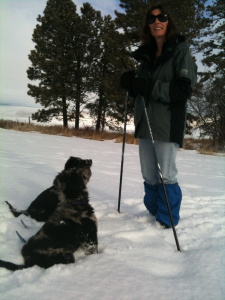
First time skiing!
All in all, the trip was a success. We skied about 30 acres, climbing the slope and then ending with a long glide back to the house. The puppies went straight to their beds for a nap.
Solstice is a time for reflection. Quietude. Can’t do much outside, or for very long. Better to sit in a cozy place with a warm drink and stare at a fireplace, or a lighted tree, or a book, or children playing, or puppies napping.
I’m 44, probably midway through my life (if I’m lucky) or midway through my adulthood (if I’m not as lucky). At this point I feel pretty comfortable with everything I do. Driving, work, marriage. How people work. I feel like I’ve got a handle on things. There’s been a lot of practice along the way, and a lot of lessons learned.
This is, of course, not to say I know everything—I’m smart enough to know that a lot of people are much smarter than I am. Plus: I’m enjoying my graduate studies; I still want to improve on fiddle and bass; I’d love to pick up Spanish again; I intend to learn to fish while I live in Wallowa County.
I’ve been around long enough to be beaten down by life a few times. Some of those times have been especially hard to take, and hard for me to shake. Starting over can seem like regression; how many times am I going to liquidate my possessions at a yard sale only to replace them shortly thereafter? But maybe it’s like shedding a skin. Or a rebirth; a new chapter. A new year is coming, I’m 44, and I feel like it’s important to look forward. So I’m going to make an effort to leave behind the darkness of past injustices and head toward the light of new opportunities.
As I typed that, a deer and her fawn walked past my window, down the driveway. Following the sun. I’m going to take that as a good omen.


December 15, 2013
Responsible Online Shopping
This time of year, gift-giving is on most people’s minds. Let’s say you want to shop locally and support local artisans and businesses—great! But what if you live in a remote area with limited offerings? You can only give your relatives the same crocheted pot holders so many years in a row. And if the roads are too treacherous to go to the nearest city (in our case, more than an hour away)? You might have to resort to online shopping.
But that doesn’t mean you have to throw your values out the window. There are online options that still honor the idea of “Buy Local,” even if it’s a little less direct. I am partial to Etsy, where makers of handmade things can create their own “shops.” Like this shop, ithaka literary ephemera!
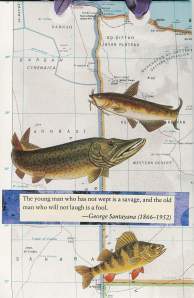
Yes, this is a thinly veiled plug for my collage art
But I don’t just sell things on Etsy—I have also purchased soap, lotion, pajamas, oven mitts, clothing, jewelry, Christmas tree ornaments—even an iPhone case made in Michigan of Forest Stewardship Council-approved cedar! Currently, I’m considering handmade dog beds and collars …
Etsy isn’t even your only option! I found an article that sizes up different sites pretty well, here.
Etsy sells some food items—I have bought bitters, vanilla extract, and honey—but not groceries per se. Which brings us to the food-buying clubs! They are popping up all over the country. The basic premise is a bunch of consumers banding together to qualify for discounts on food, usually organically grown. Sometimes the purveyor is a farmer or rancher, sometimes an amalgamator, sometimes both. There is usually a drop-off site; the food delivery does not go directly to your house but to a central location in your community, and you go pick up your box. Buying clubs differ from CSAs (community-supported agriculture) in that there is no up-front cost and no risk—you only pay when you have purchased a delivery. Further, you choose what you receive. Buying clubs are often run by volunteers, like cooperative grocery stores, so you might be asked to help here and there with a delivery.
One of the biggest buying clubs in the Pacific Northwest is Azure Farms, based in Dufur. They are a “both”—they offer a number of processed items, even non-food items, and also sell the grain they grow in north-central Oregon. I requested their catalog when I was still in Portland, and haven’t signed up yet, but plan to this week! A friend who lives in Pendleton, about one and a half hours from here, is in a buying club that works with organic farms in the Southwest United States and Mexico—last week she posted photos of her avocados and grapefruits. I was more than a little envious; might need to establish a buying club stop in Enterprise …
People in cyberspace are trying to collect information about small farms and co-ops in directories and “food hubs.” Here are a few:
The greenest business transaction is one, in cash, that supports a neighbor. But when that isn’t possible, buying responsibly using the internet is the next-best thing!


December 8, 2013
Winter Puppies
The smart time to get a puppy is in the spring—the days are warmer and longer, and it’s easy to get a puppy outside for exercise and training. As you might know from a previous post, Mike and I got a puppy in October. Two, in fact. In October. I never said I was smart.
I know winter is a bad time to get a puppy, because I’ve done it before. We got Phynn in December 1997. But we have been blocked by circumstance from having a dog for so long that I feared something would come up between now and spring that might foil our plans. We decided to go for it.
And so, here we are, in the middle of a deep freeze with two ten-week-old puppies.
The main thing to watch is that their extremities not get too cold. That means long hikes around the outer reaches of our field are on hiatus, and many shorter walks are the ticket. Their feet were toughened up pretty well before the snow started flying, but they are still little bitty puppy feet. And their bellies are just an inch or two from the crust of the snow. Poor Pendleton gets an ice ball that forms around the hairs at the end of his little Johnson every time he goes out! However, they do expend a lot of energy bounding through the snow, so the shorter walk is still good exercise.
The house we are renting is well outfitted for dogs—gates are built into many passageways between rooms, and a bunker-style doghouse anchors the fenced backyard.
Speaking of the fence, we are waiting for the dogs to grow big enough that they can’t squeeze through the one panel of fence that has larger holes in it. Cap’n is particularly adept at escaping, especially now that the snow gives her a couple inches of added height.
I bought a bale of cedar chips for the doghouse-fort, but they didn’t work: Cap’n was constantly trying to eat the chips, and they were so odiferous that Pendleton wouldn’t go near it (cedar is a delicious smell to me, but not to him …). So Mike replaced the chips with straw, to great success. Even when the wind howls down from the ridge, the doghouse-fort is warm and dry.
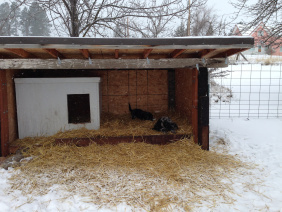
Best doghouse ever! See the puppies in action at http://www.youtube.com/watch?v=mBLMLkz2lqg
Since the puppies have to be inside most of the time, it is imperative to give them lots to do. I get small stuffed animals and other children’s toys at the local thrift shop—way cheaper than buying official dog toys at the hardware store. I just make sure they don’t have any little pieces (wheels, hats, etc.) that can be chewed off. I’ve gotten a number of old blankets and towels (for wiping snow from feet and Johnsons) there as well.
Even with the inconveniences of wintertime puppy husbandry, I’m so happy we didn’t wait to get dogs.



